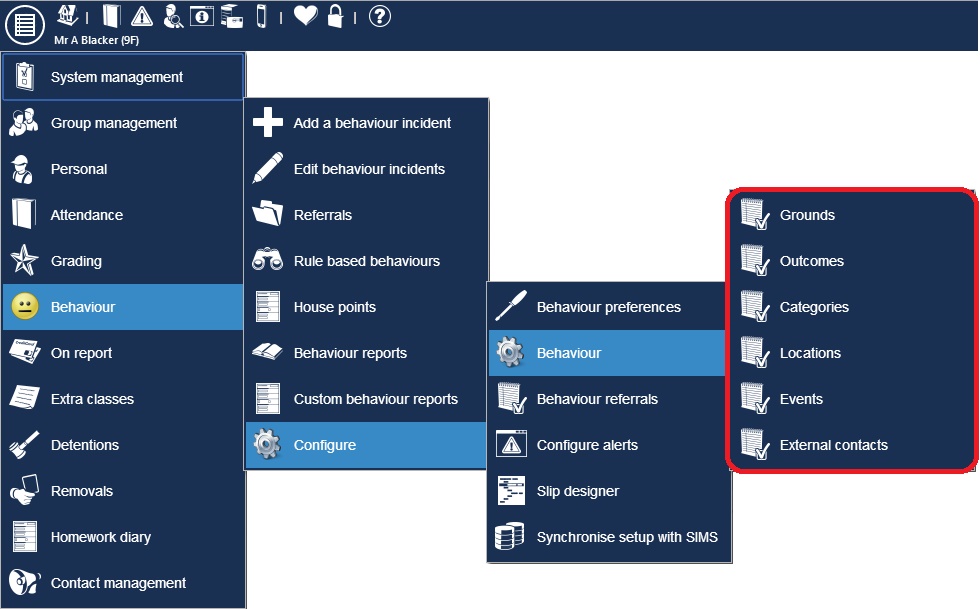Difference between revisions of "Configure behaviour"
| Line 47: | Line 47: | ||
'''Go to the [[configure events]] page for more information.''' <br> <br> | '''Go to the [[configure events]] page for more information.''' <br> <br> | ||
| − | |||
| − | |||
| − | |||
| − | |||
| − | |||
[[Category:Behaviour]] | [[Category:Behaviour]] | ||
[[Category:Configuration]] | [[Category:Configuration]] | ||
Latest revision as of 09:33, 7 July 2016
| Permissions required to access this module: | |
| Section: | |
| Behaviour | |
| Permission(s): | |
| Access ___ behaviour incidents | |
| Configure behaviour schemes | |
There are various aspects of behaviour that can be configured in PARS. Each of these areas are usually not accessed by the majority of staff. Below are brief explanations of each of the configuration menu items, with links to pages with more in-depth instructions and information.
This page is accessed via:
PARS main menu > Behaviour > Configure
Below is a screenshot of the menu items for configure behaviour. Lower down this page there are explanations of each option. If you are configuring behaviour for the first time, you should go to each of the pages in the order that they appear on this page.
If you are configuring behaviour in PARS for the first time, then you will need to create Grounds and Outcomes. These are the equivalent of Types and Outcomes in SIMS.
If you want to use the same Types and Outcomes as you have in SIMS, you should first go to the synchronise setup with SIMS page which allows you to copy the behaviour setup from PARS to SIMS or vice versa.
Outcomes
"Outcomes" are the equivalent of "Outcomes" from SIMS; when recording behaviour, the "Outcome" is what the staff member is going to do in response to the pupil's actions. Add outcomes to be selected from a dropdown list when behaviour incidents are recorded. You can perform an analysis of the outcomes used with Behaviour reports or Custom behaviour reports. Outcomes can also be categorised for ease of selection.
In PARS, points are attributed to the outcomes, not to the grounds (types).
- For example: in SIMS, the behaviour Type "Great work" might be worth 5 points, and teachers could issue "verbal praise" or a "silver certificate". Either way the incident is worth 5 points. In PARS "Great work" is not worth any points. Instead the points come from the outcome, so "verbal praise" might be worth 3 points and "silver certificate" might be worth 6; in PARS it is the outcome that defines the magnitude of an incident.
Go to the configure outcomes page for more information.
Grounds
"Grounds" are the equivalent of "Types" in SIMS; when recording behaviour, the "Grounds" are what the pupil(s) have done. Add grounds to be selected from a dropdown list when behaviour incidents are recorded. You can perform an analysis of the grounds used with Behaviour reports or Custom behaviour reports. Grounds can also be categorised for ease of selection.
Go to the configure grounds page for more information.
Categories
In PARS grounds and outcomes are categorised to make it easier and quicker for staff to enter behaviour incidents. When adding a behaviour incident, staff must choose the category first. They will then only see grounds and outcomes related to that category. Commonly used categories are:
- Attendance
- Behaviour & Attitude
- Equipment & Uniform
- Work
Go to the configure categories page for more information.
Locations
Locations are used in PARS to record where events are occurring. You can use this data to organise detentions, host extra curricular classes, analyse behaviour and create heat maps. When teachers record behaviour via their register, PARS will use the details from your SIMS timetable to work out which room the teacher is in; teachers do not have to input this information themselves!
Go to the configure locations page for more information.
Events
Event is the term used in PARS for "Period of the day". Events are used in PARS to record when behaviour is occurring. Events will automatically be imported from SIMS to reflect your timetable i.e. Thurs:1, Thurs:2, etc. However you may wish to use events that do not occur on your timetable, such as before and after school. When teachers record behaviour PARS will use the details from your SIMS timetable and the current time to work out which period of the day it is; teachers do not have to input this information themselves!
Go to the configure events page for more information.
